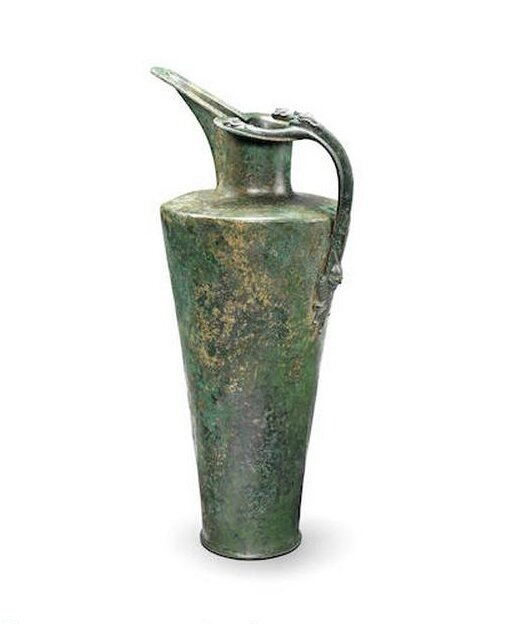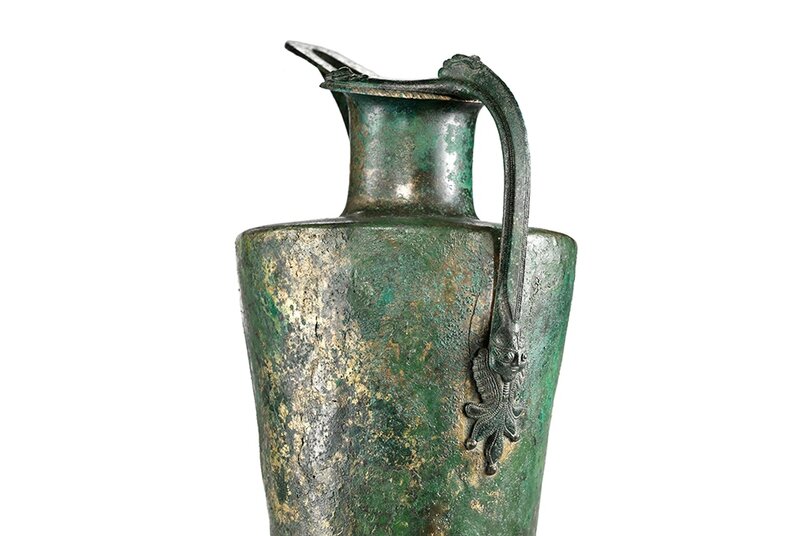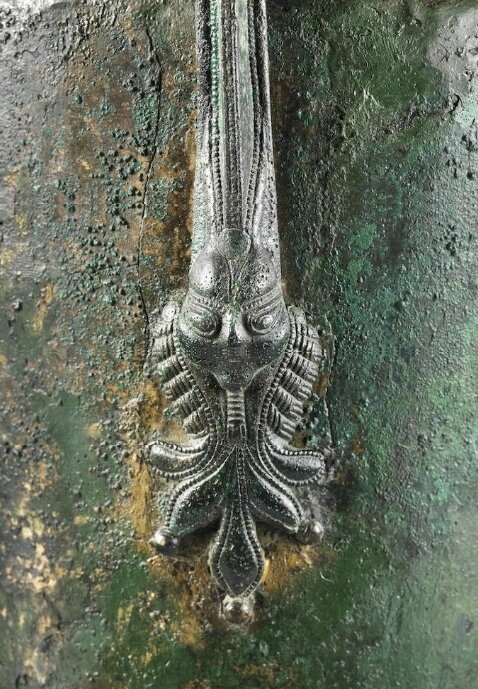Rare 5th century BC Celtic bronze flagon for sale at Bonhams
A large Celtic La Tène bronze beaked flagon, circa late 5th Century B.C. Estimate £70,000 - 90,000 (€96,000 - 120,000). Photo Bonhams.
LONDON.- A rare and impressive 5th century BC Celtic bronze beaked flagon leads Bonhams next Antiquities sale in London on 30 September. It is estimated at £70,000-90,000.
Its appearance on the market coincides with a major exhibition of Celtic art opening at the British Museum in late September.
The flagon is one of the only examples in private hands and this is a rare opportunity to acquire a Celtic masterpiece comparable to those exhibited at the British Museum itself. Celtic art has a unique and distinct style that makes it particularly appealing and Bonhams are excited to offer such an exceptional survivor from this important period in European pre-history.
The beaked flagon would have been used for pouring wine, beer or mead at feasts and it is easy to appreciate the luxury that this elegant piece emanates. It was modelled on the shapes used by the Etruscans but decorated with typical local Celtic motifs on the spout and handles, giving an interesting insight into the multi-cultural aspects of the Iron Age.
Although it is difficult to pinpoint its exact place of origin, a very similar vessel known as the Kleinaspergle flagon was found at Hohenasperg, near Stuttgart, among a group of drinking vessels in a princely tomb. The tomb was typical of the early La Tène culture which predominated in a region roughly corresponding with modern day France, Belgium and Germany between the fifth century BC and the Roman conquest in the first century BC.
Bonhams Head of Antiquities, Madeleine Perridge, commenting on the flagon, said: “Very few of these impressive artefacts have survived. The sophisticated decoration on the flagons and their presence in tombs of the aristocracy suggest they were as highly prized then as they are today.”
A large Celtic La Tène bronze beaked flagon, circa late 5th Century B.C. Estimate £70,000 - 90,000 (€96,000 - 120,000). Photo Bonhams.
The tall slender body tapering towards the flat circular base and flaring towards the flattened shoulder, the beaked spout etched along the flattened rim with interlinking scroll motifs, the separately cast ribbed handle surmounted by a central mask, dividing at the rim into two arms with further mask terminals, each with exaggerated features with bulbous eyes, the lower handle attachment plate cast with a mask issuing from a palmette, the features with satyr characteristics including pointed ears, with incised details, 48cm high
Provenance: German private collection, acquired in 2006.
German private collection, acquired in the 1980s.
Luxembourg private collection, acquired prior to the 1980s.
Literature: Flagons such as the above example were used for holding wine, beer or mead at feasts. The flagons copied the shapes used by the Etruscans while using typical local Celtic motifs for the decoration of the separately cast spouts and handles. Very few of these impressive flagons have survived.
The above flagon most closely resembles the 'Kleinaspergle' flagon from the region of Hohenasperg, in the Württembergisches Landesmuseum Stuttgart. They both share the same angular elongated form and decorative elements on the handles. For a discussion of the'Kleinaspergle' flagon found amongst a group of drinking vessels in a 'princely tomb' typical of the early La Tène Period cf. S. Moscati (ed.), The Celts, New York, 1991, pp. 127-129.
Similar examples of elongated bronze flagons are exemplified by the impressive Basse Yutz flagons in the British Museum and the Dürrnberg flagon in the Museum Carolino Augusteum, Salzburg, cf. S. Moscati (ed.), op.cit., p. 171, for the flagon of Dürrnberg, tomb 112, near Hallein, Salzburg, Austria; and pp. 194-195, for the Basse Yutz flagons, Lorraine, France, now in the British Museum.
Bonhams. ANTIQUITIES, 30 Sep 2015 14:00 BST, LONDON, NEW BOND STREET

/https%3A%2F%2Fprofilepics.canalblog.com%2Fprofilepics%2F1%2F0%2F100183.jpg)
/https%3A%2F%2Fstorage.canalblog.com%2F03%2F02%2F119589%2F96711876_o.jpg)
/https%3A%2F%2Fstorage.canalblog.com%2F11%2F31%2F119589%2F94773502_o.jpg)
/https%3A%2F%2Fstorage.canalblog.com%2F20%2F83%2F119589%2F94772815_o.jpg)
/https%3A%2F%2Fstorage.canalblog.com%2F26%2F72%2F119589%2F75604929_o.jpg)
/https%3A%2F%2Fstorage.canalblog.com%2F59%2F60%2F119589%2F26458628_o.jpg)






/image%2F1371349%2F20240406%2Fob_b23648_434058570-1644317966338216-88086167391.jpg)
/image%2F1371349%2F20240403%2Fob_6d5ae7_dp-28103-001.jpg)
/image%2F1371349%2F20240229%2Fob_8f31f9_431013694-1625286614908018-33034430839.jpg)
/http%3A%2F%2Fstorage.canalblog.com%2F79%2F20%2F119589%2F129837997_o.jpg)